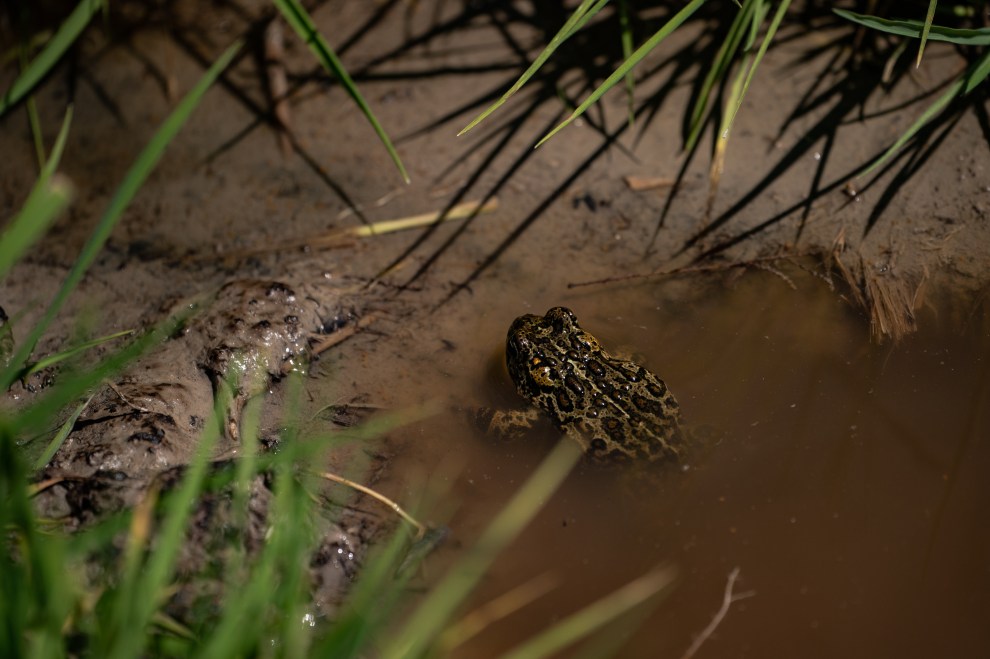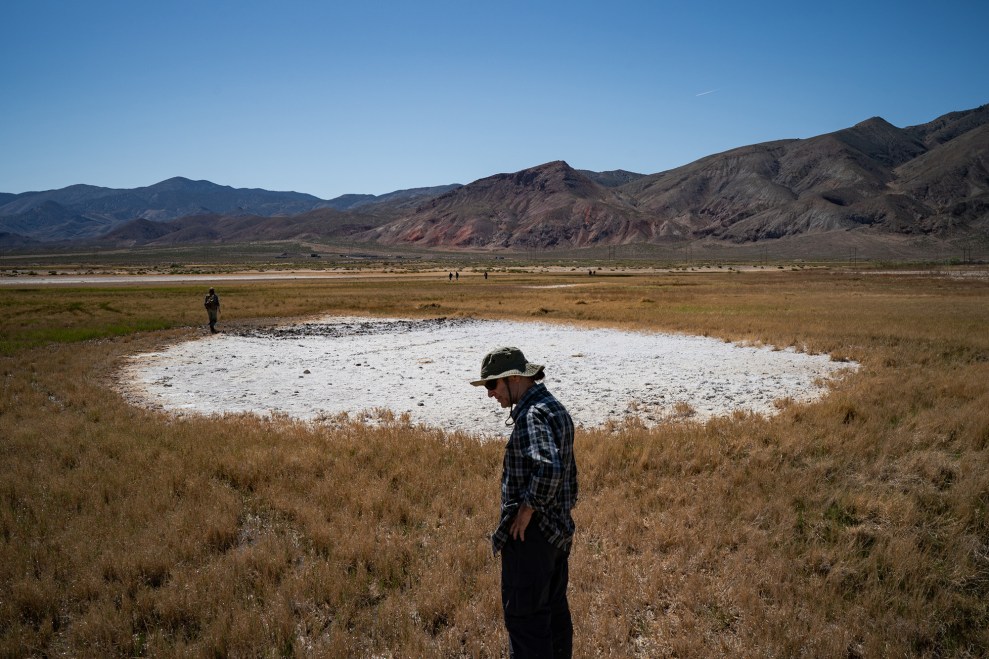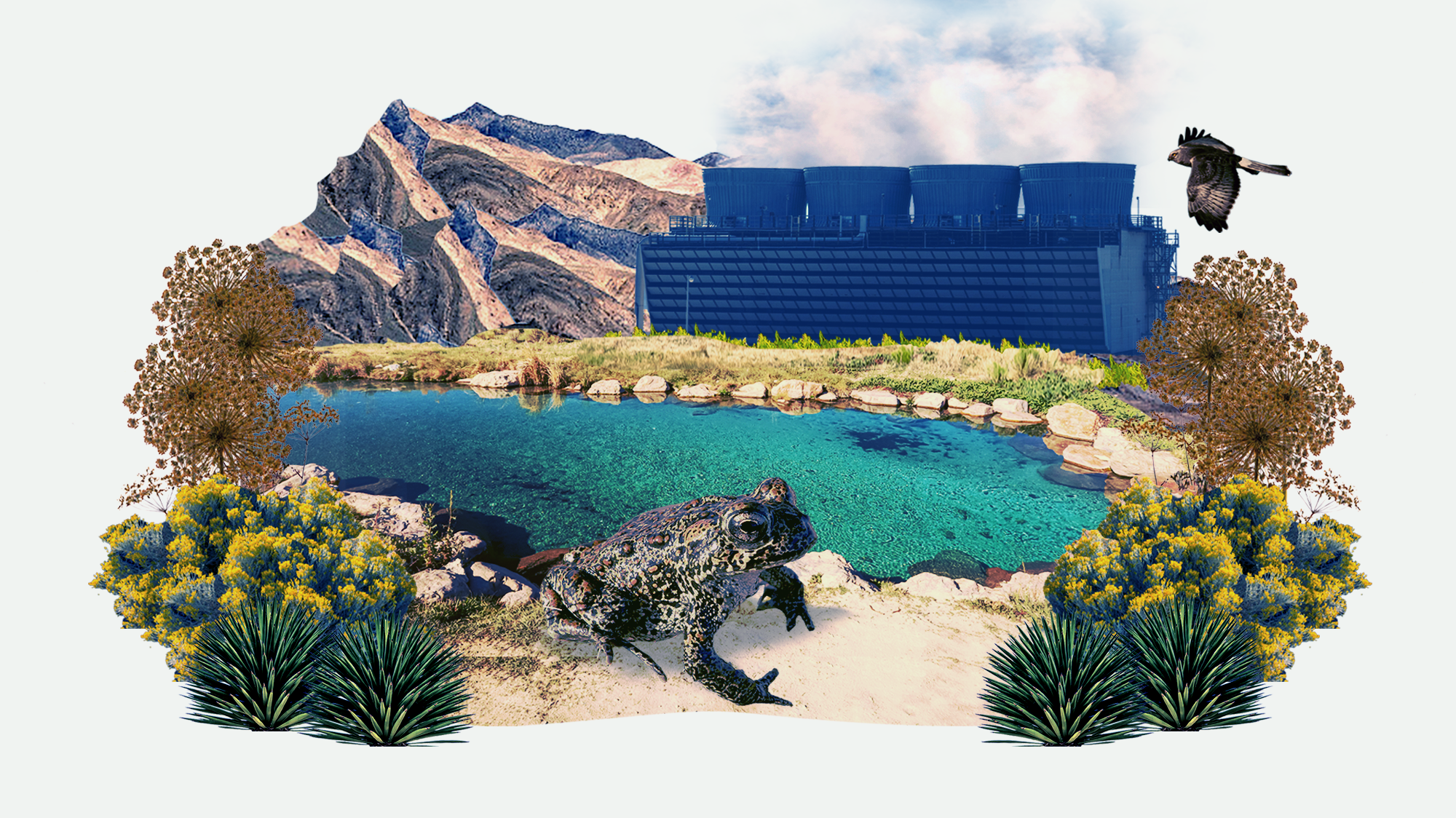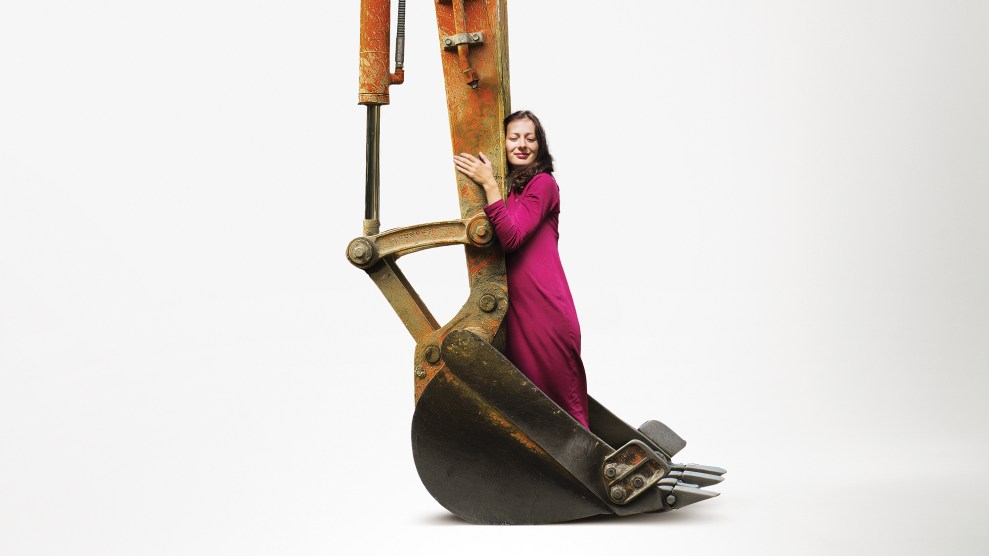The Endangered Species Act has been one of the country’s most valuable environmental tools, but it faces new threats. As the law turns 50, we’re asking whether this “pit bull” of an environmental law, as one expert described it, can survive the challenges of our time—from political attacks to climate shocks. You can read all the stories here.
Almost as quickly as the Dixie Valley toad was discovered, it became apparent the toad could be lost.
Richard Tracy, a biology professor at the University of Nevada, led the team that first noticed the amphibian back in the early 2000s. It was morphologically distinct from others in the area, with huge eyes compared to its very small body—the smallest of any toad in the western United States. Combined with its perpetual frown and stout figure, the creature was immediately charismatic. “A pretty toad, with flecks of gold on an olive background,” as Tracy described it, “it’s not like the big, common green toads you might find in other marshes around the West.”
It was unique in other ways, too. The toads, which Tracy’s team calculated have been around since the time of the mammoths, were discovered in one small part of Nevada, a 760-acre oasis of hot springs in the Great Basin Desert. “The toad is finely attuned” to the waters, explains Patrick Donnelly, the Great Basin director of the Center for Biological Diversity. It “bases its whole lifecycle around moving up and down the brook coming out of the hot spring. They just find that sweet spot where the spring has cooled off to their perfect temperature and they move with the seasons accordingly. It’s incredible.”
But the Dixie Valley toad’s dependence on the hot springs is also its greatest vulnerability. Since 2007, Ormat Technologies, an Israeli renewables company, has had plans to build a geothermal plant that could disrupt the very springs the toads rely on. The plant could offset an estimated 6.5 million tons of CO2 and provide electricity for 44,000 homes by pumping hot water from beneath layers of rocks.
Geothermal energy has been touted as a near-limitless energy resource: Just a tenth of a percent of Earth’s heat could supply humanity’s total energy needs for 2 million years. The Department of Energy has said the clean technology has the potential to produce nearly five times the capacity of the electricity generated by utilities in the United States as of 2016. “I am obsessed with geothermal,” Energy Secretary Jennifer Granholm said earlier this year, perhaps in reference to her project, announced in 2022, to cut the cost of geothermal production by 95 percent. The technology, according to her department, “will go a long way toward reaching President Biden’s goals of 100 percent carbon-pollution-free electricity by 2035 and net-zero emissions across the US economy by 2050.” The 2022 Inflation Reduction Act provides geothermal companies the same tax credits as solar and wind, to bolster production.
But tapping into all of this “heat below our feet,” as Granholm has called it, can only happen if geothermal companies, which stand to make a pretty penny off these new investments, can get around advocates who say many of these projects are decimating crucial habitat for endangered species. In this way, the discovery of the Dixie Valley toad has unveiled a larger fight plaguing the environmental movement. Should we double down on regulations like the Endangered Species Act that paved the way for a clean environment 50 years ago? Or should we look at them as relics of the past, ill-equipped for a green energy transition?
As some see it, the decision in the Dixie Valley boils down to: save million of tons of CO2 or a couple of hundred irreplaceable toads.

A Dixie Valley toad around the hot spring–fed wetland in the Dixie Valley in Fallon, Nevada.
Salwan Georges/The Washington Post/Getty
Ormat Technologies has been involved in renewable energy since before it was cool. The company, now valued at nearly $7 billion, opened its first geothermal plant 40 years ago, in Nevada, which quickly became Ormat’s home in the United States; in 2011, as a first step toward investing in the future of geothermal, the Department of Energy gave Ormat a $350 million partial loan to increase production in the state by almost 25 percent. Today, Ormat has more than 20 plants across the West with a combined generating capacity of over 900 megawatts, meaning it powers about 540,000 homes per year.
Over the years, its geothermal plants have run up against endangered species concerns. Ormat moved a geothermal plant to be further away from the bleached sandhill skipper, a pale yellow butterfly on the waiting list for endangered status. Activists also raised the alarm that multiple Ormat projects would harm the sage-grouse, a “near threatened” bird known for its peacock-like mating displays. The company won an award in 2012 for efforts to reduce its impact on the bird. But a study published in the journal Biological Conservation in April 2023 (funded in part by Ormat) showed sage grouse populations have been declining in areas within close proximity of geothermal development.
Ormat may have thought it would avoid such backlash with its Dixie Valley project, since in 2007, when Ormat first began exploring geothermal drilling in the valley, the region appeared devoid of endangered species.
But that was before Tracy and his team of graduate students made an astounding discovery. At the time, the University of Nevada group was deep in a study of the area’s toad species. One of those students was Michelle Gordon. When she headed out in the field to measure the tiny features of Dixie Valley toads, she expected to prove the null—that they were a subspecies of an already known toad. “I thought it was impossible,” Gordon told me. “I mean come on.” No new toad species had been identified in the United States in nearly 50 years; the last toad discovered, in 1968, had since gone extinct.
Gordon measured every bit of more than 400 toads, ranging from their femur and eyelid length to the makeup of more than 1,600 base pairs of their genes. The gravity of these differences proved these toads were not just a subspecies. As it became clear she was working with a unique species, the stakes changed. The population of toads was small and highly reliant on its ecosystem, meaning that small shifts in the environment could lead to big population changes. Even without impending development, the toad was at risk of disease, drought, and predation. In other words, “the species was already imperiled,” Gordon said.
In 2012, Gordon and Tracy met with Ormat and the Bureau of Land Management about the ramifications of their discovery. Ormat has always maintained that they “recognized the importance of conserving the Dixie Valley toad, regardless of its legal status.” But the mitigation suggested was vague, emphasizing protection measures “wherever possible” or “if possible” without giving detailed actions. A key step of the mitigation plan was monitoring local wildlife for changes, with the assumption that if there was a dangerous shift to the ecosystem, new mitigation plans could be implemented. “It was a wait-and-see approach,” Gordon explains. That method was inadequate for such a precarious species. “If they interrupted the spring flows, even for a summer, that could cause the extinction of the species,” she says, referring to Ormat’s interference with the hot springs. “It’s too great a risk.”
Upsetting, too, was the fact that there were numerous other locations across the Great Basin with hot springs viable for geothermal development and no at-risk species. Yet Ormat moved forward with its plan. In 2017, when Gordon and Tracy finally published the research confirming their new species discovery, they did not mince words: “The habitat occupied by this newly described species is threatened by the incipient installation of geothermal and solar power development projects that require the water that defines its habitat.”

Scientists John Gray, technician at University of Nevada at Reno, right, and Michelle Gordon, former University of Nevada at Reno student, look for Dixie Valley toads around the hot spring–fed wetland in the Dixie Valley in Fallon, Nevada.
Salwan Georges/The Washington Post/Getty
There was little Tracy and Gordon could do without any special protective designation for the toad. So in September 2017, they worked with the Center for Biological Diversity to petition for the toad to be listed under the Endangered Species Act.
Four years later, the toad was still on the waitlist to be considered endangered, not a rare occurrence, though one that can be a death sentence for some species. Ormat’s plans, on the other hand, were moving forward. In November 2021, the BLM approved Ormat’s project, explaining in a press release how the energy that the plant would produce would help toward state and federal clean energy goals.
Weeks after Ormat’s Dixie Valley project was approved, the Fallon Paiute-Shoshone Tribe, along with the Center for Biological Diversity, sued the Department of the Interior under the Religious Freedom Restoration Act and the National Environmental Policy Act. The lawsuit made a case for the toads, but also argued that the drilling project would illegally desecrate the hot springs, which have religious and cultural significance to the tribe. It also asserted that the BLM did not do enough “to understand or properly analyze the Project’s environmental impacts.”
The pair initially won a stay of the project, but that was quickly overturned by an appeals court. Ormat’s argument that they stood “to lose $30 million over twenty years” was compelling to the court. The case forced the judges to compare the “irreparable economic harm to Ormat” with the “harms to Plaintiffs’ aesthetic, recreational, and religious and spiritual interests.” Notably, the judge also highlighted “the public interest in ‘a source of carbon-free baseload electricity.’”
“The unfortunate reality is that endangered species have more protection than Native American cultural traditions,” Donnelly told me. If the land was to be protected, it rested on the small shoulders of a dime-sized toad and whether the toad could get listed as an endangered species.
Yet how and whether to push for an ESA listing—at the expense of green infrastructure—remains an open question, even for climate experts. The environmental movement, says legal scholar J.B. Ruhl, must make choices about what it is willing to sacrifice to make the transition to clean energy, and what hard lines must not be crossed. Some of those calculations mean looking at the risks of the future. “You could save five bats now or doom the whole species later,” says Ruhl. “That’s an extreme statement. But there is a trade-off in terms of species conservation if we don’t turn the corner on emissions.”
Robin Craig, another legal expert on the ESA, echoed the sentiment: “Endangered species are not going to be a whole lot happier if we let climate change keep going the way it’s going to.”
When I asked Gordon what we get out of protecting the toads, she conceded that the toads are not a keystone species that the entire environment depends on for survival. Their death may not cause catastrophe to the ecosystem. But, she emphasized, safeguarding them could help with the survival of the ecosystem anyway. “The protection of these species would act as an umbrella for other species,” Gordon said. “They are endemic to a rare habitat that is an oasis for other rare wildlife,” such as bighorn sheep, mule deer, golden eagles, and many migrating birds. In the Great Basin there are no streams or water corridors, she explained, so losing an oasis is devastating for the landscape. “Because of the toad’s critical reliance on the wetlands, protecting them protects the oasis, which protects the ecosystem.”
For Donnelly, of the Center for Biological Diversity, laws like the Endangered Species Act are crucial for reining in companies seeking to take undue advantage of the massive amounts of new climate money. “It doesn’t matter why Ormat’s going to drive [the toad] extinct. It could be for green energy. It could be for an orphanage,” says Donnelly. “The law does not discriminate. And it shouldn’t. That’s the whole point. The point with the ESA was that we don’t allow things to go extinct. That’s this country’s bottom line. You could come up with all sorts of virtuous reasons why you’re going to drive species extinct, but it’s just unacceptable.”
At the start of 2022, as Donnelly took last-ditch press photos of the Dixie Valley Toad, the fight seemed over. Then, in April 2022, a miracle happened. “The Dixie Valley Toad was emergency listed under the ESA,” Donnelly told me. “It was the first emergency listing in 10 years. And only the second in 20 years. It was very unusual.”
The bolstered protections halted Ormat’s construction. But, both the BLM and Ormat stood by their earlier assessments that there were “sufficient safeguards in place to avoid endangering the toad.” The pair have continued to try to find a way to keep building, launching an environmental assessment for a smaller plant in Dixie Valley that would produce just 20 percent of the original proposed energy. “For us, the precedent is terrifying,” Paul Thomsen, Ormat’s vice president of business development, said, referring to the toad’s emergency listing. “If this action were to stand, many renewable projects in the West could be thwarted simply based on a concern, with no evidence that they may impact a species in the future.”
Ormat claims that the US Fish and Wildlife Service used outdated data on old geothermal technologies no longer in operation to calculate risk, and maintains that its other geothermal plants, including one in Jersey Valley, have not dried up nearby hot springs. When asked about the Jersey Valley plant, Thomsen told the Bulletin of the Atomic Scientists that “No data has definitively established Ormat as responsible for the loss of flow there, even though we’re there” and pointed the finger at the mining industry.
There is hope for compromise. The Desert Renewable Energy Conservation Plan (DRECP), which seeks to produce 20,000 megawatts of energy across millions of acres of land in California, is one such example. The area for the solar panels, wind turbines, and, yes, geothermal energy plants is also the home of species like the desert tortoise, which has been listed as threatened for over 30 years. But early on, the California Energy Commission and the BLM worked with groups like the Center for Biological Diversity to come up with a plan for the project that would minimally effect the natural environment.
“It took a look at the whole California desert and said, ‘Where are we going to put solar to have the lowest ecological conflicts? And where are we going to allocate for conservation?’” Donnelly says of the project. “It took years to put together. But in the end, we got two and a half million acres of the desert preserve, and we lost 500,000 acres of the desert to solar panels. But that was a pretty good deal, you know. It is a model that works.”
If applied to the Great Basin, a plan like California’s would mean finding places for geothermal energy that do not threaten rare species or sacred sites. Activists and scientists have called on Ormat to use a framework similar to the DRECP. But neither the company’s original nor its altered plan show such foresight. The lawsuit, meanwhile, remains open, and newly bolstered by the protection of the Endangered Species Act. So a court, not activists, will have the final say on whether the Ormat plant will be built.
For Gordon, the cost of Ormat’s Dixie Valley plant is too high. “If we lose a population of Western toad, that’s nothing. They are everywhere,” Gordon says. “If we lose the Dixie Valley toad, it’s losing something special.”
















